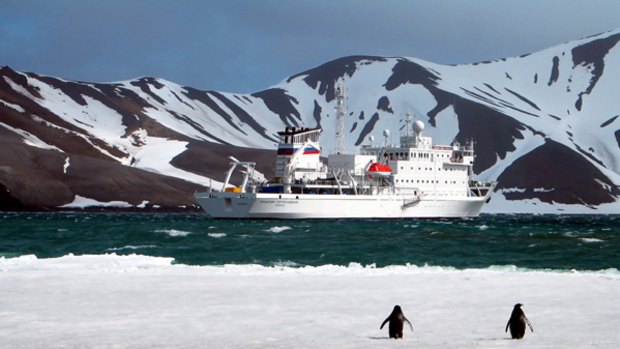
Penguins welcome the Peregrine Voyager to the Antarctic.
Amid all the gloom that the global recession is casting over the tourism industry, there is one small ray of sunshine more people than ever before are travelling to the Antarctic.
Tourist numbers have increased fourfold in the past 14 years. International Association of Antarctica Tour Operators (IAATO) figures show that 7000 tourists headed south in 1992. During last year's summer season the association estimates about 34,000 people landed on the frozen continent.
Cruise liners typically carry more than 2000 passengers and about 95 per cent of vessels leave from South America, bound for the Antarctic Peninsula region, just a few days' journey away.
In February, an Australian Senate estimates hearing heard that total travel to Antarctica had more than doubled in nine years. In the last financial year, the Australian Antarctic Division told the hearing, there were 46,000 visitors. In 1999-2000, the number was just 20,000. That includes fly-over tourists and cruise liners, which do not berth.
But is this really good news? And what of the environment? With more people attracted to the so-called "last frontier" how are travel companies and environmental organisations ensuring the environment is preserved?
So far, cost has kept Antarctica a niche destination. Tourists pay as much as $10,000 to witness the unspoilt beauty of the landscape that is home to an abundance of animal life.
Most tourist operators hold IAATO membership and must adhere to treaty regulations, which impose guidelines for tourists and expedition organisers.
Under the regulations, operators must submit reports on their visits and ensure contingency planning. Also imposed are landing requirements, maximum visitor numbers and adherence to walking areas.
But the issue is firmly on the agenda again after two ships ran aground last season. The Bahamas-registered MV Ocean Nova hit ice in February and the Argentine Ushuaia followed suit in December. In 2007, the Canadian ship Explorer hit an iceberg and sank within 24 hours. The 154 passengers were rescued by a Norwegian cruise ship.
Poor mapping and rapidly changing ice conditions have been blamed for the incidents. But the Argentine and Chilean navies have warned that they do not have the resources for any large-scale rescue operation.
"We are just waiting for a disaster," Johannes Huber, executive secretary of the Antarctic Treaty Secretariat in Buenos Aires, which oversees the 1959 treaty system, told the San Francisco Chronicle in March.
"So far no one has lost their lives in any incidents ... it is only a matter of time. Now theships are getting bigger and that is of greatconcern."
Last month, ecotourism and environmental threats were the lead item on the agenda of the 32nd Antarctic Treaty Consultative Meeting in Baltimore. US Secretary of State Hilary Clinton addressed the meeting, heralding amendments to Annex VI of the treaty system, which sets out rules relating to the liability of operators who fail to respond to environmental emergencies.
"Strengthening environmental regulation is especially important as tourism to the Antarctic increases," she said.
"The US is concerned about the safety of the tourists and the suitability of the ships that make the journey south. We have submitted a resolution that would place limits on landings from ships carrying large numbers of tourists. We have also proposed new requirements for lifeboats on tourist ships to make sure they can keep passengers alive until rescue comes."
In February, the Australian Antarctic Division's Virginia Mudie told the Australian Senate that the increase in numbers had not caused environmental damage.
"All tourist activities must undergo an environmental assessment before they can proceed to Antarctica," she said. "And there's no sign of these carefully managed activities causing any environmental impacts at this point in time. Australia's concerned about incidents but mostly they're off the peninsula area, not the east Antarctic region."
Charles Sturt University lecturer Dr Rosemary Black has suggested that increased tourist numbers require continued monitoring. Black, who travelled to Antarctica five times last season aboard a tourist ship, said she had been pleasantly surprised by the lack of impact. But she said it was important that operators remembered what tourists came to see.
"For the majority of people who go, it is an absolute dream and they have saved for many years to be able to afford it," she said. "It's not a cruise, it's an adventure. So these people are already committed to protecting the environment and they are receptive to learning about Antarctica and its wildlife and how to behave appropriately."
Black said ships travelled to different sites across the Antarctic Peninsula, so potential impact was well distributed. Most cruise companies also employed marine biologists, ecologists and geologists whose on-board lectures were well-attended.
"People are keen to learn more and so these trips have the capacity to create advocates for conservation," she said.
Australia's largest tourism operator in Antarctica, Peregrine Adventures, operates two vessels with a maximum of 110 passengers and observes a guide to passenger ratio of 1:20.
"It's impossible to say whether tourism numbers will keep growing," said Peregrine's marketing manager, Jane Reed. "Our bookings are holding up and there has been increased interest, particularly with the increased awareness around climate change. We absolutely adhere to all of the guidelines ... and we respect all of the guidelines regarding proximity to animals."
Sign up for the Traveller Deals newsletter
Get exclusive travel deals delivered straight to your inbox. Sign up now.